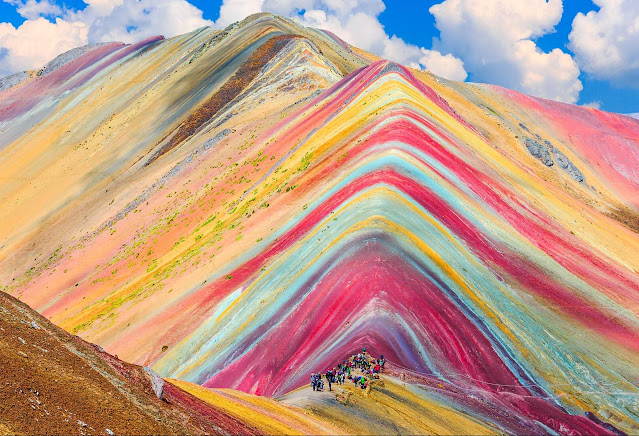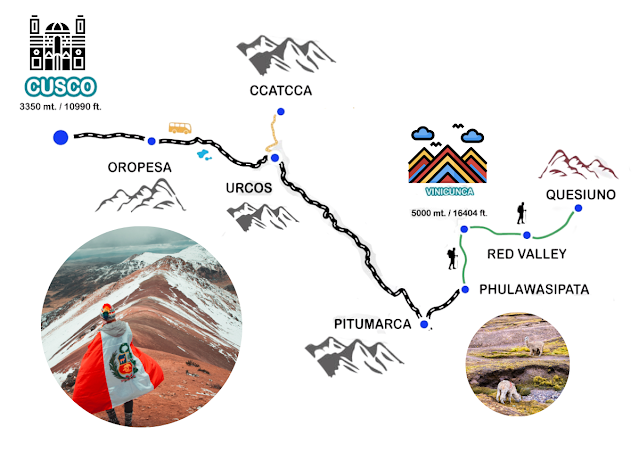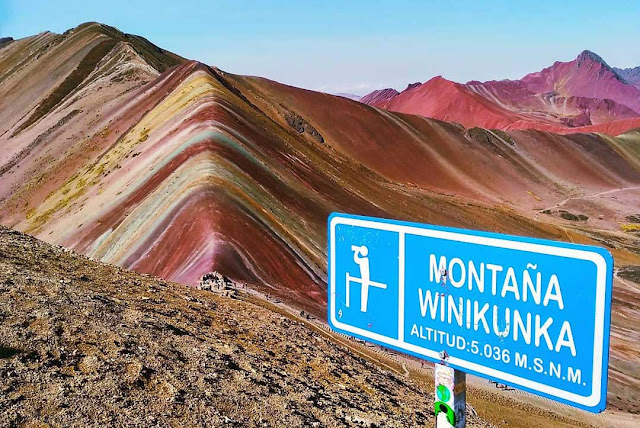If you are planning to visit the Vinicunca mountain, better known as the Rainbow Mountain, then you need to know these details so that your trip is safe and very pleasant. So join us in this complete guide that will delve into the natural appeal of this wonder, exploring its geological origins, hiking experiences and the eccentric cultural heritage that surrounds Vinicunca. Whether you are an experienced hiker or just a curious explorer, this travel guide will help you unlock the secrets of this extraordinary destination, promising you an unparalleled experience at the top of Rainbow Mountain.
This majestic mountain is considered a geological masterpiece located in the high Andes of Peru, so its acclaimed fame comes from its amazing range of colors that adorn its slopes, the result of various mineral deposits exposed over time. In which they show us dazzling shades of colors such as: red, green, turquoise and gold, which give color to this scene, attracting both people passionate about nature and intrepid adventurers. On the other hand, Vinicunca Mountain is located at more than 5,000 meters in elevation, which poses an exciting challenge for hikers, offering panoramic views of surrounding peaks and valleys.
Vinicunca: Colors and their Mineral Origins
The coleres that show off the wonderful rainbow mountain are a geological masterpiece, in which each tone represents a unique mineral composition that is embedded in each of the ancient layers of this old mountain; Therefore, this natural canvas originated from the various geological processes native to the same land. These reasons make witnessing Vinicunca valuable and charming; On the other hand, detailing each of the colors that characterize this mountain we can see:
- Red Tones: The red color of Vinicunca emanates from iron oxide, also known as oxide, giving it a crimson red color characteristic of the mountain.
- Pink Shades: Various variations of iron oxide contribute to forming the pink color features, which together with the red color creates a delicate and balanced fusion.
- Green Tones: The presence of chlorite, a mineral in the region, is responsible for the green areas, enriching the landscape.
- Yellow Hues: Sulfur in the geological composition is the source of the yellow tones, providing luminosity and complementing the rainbow effect.
- Blue Tones: Limestone, a sedimentary rock rich in carbonate minerals, is the cause of the blue tones, intensifying the diversity of the mountain.
- Brown Nuances: Manganese oxide, with its earthy pigmentation, provides warmth and depth to the chromatic spectrum.
- Golden Nuances: The golden glow of Vinicunca is originating from a mixture of minerals, such as iron sulfide and other elements present in the rock.
Hiking in Vinicunca: Location and Access
The rainbow mountain or Vinicunca is located specifically in the Pitumarca district in the fascinating Andes Mountains of Peru, in the Cusco region, so this natural phenomenon is accessible from the city of Imperial and serves as a historical starting point and cultural.
Map of Vinicunca
Before entering this destination, you must first know the terrain to enjoy a safe and peaceful trip, mainly you should know that this mountain located in the Peruvian Andes, offers a captivating combination of natural beauty, cultural wealth and challenging landscapes, this is reflected on this detailed map that serves as a crucial tool for tourists looking to explore this vibrant destination.
Also, this map highlights the various key points of interest, including the starting point of the hike, viewpoints for panoramic views and important landmarks along the trail; so understanding the terrain is essential, as the route involves elevation changes, rocky paths and variable slopes.
From Cusco to Vinicunca
To start the trip to this fascinating mountain, you must first arrive in Cuzco and from this same place continue along the extensive road (approximately 90 kilometers) to the town of Pitumarca, this will be the gateway to the hike to Rainbow Mountain; through which many of the enthusiastic travelers will travel to reach their destination, crossing captivating landscapes and high-altitude terrain on their way, but although it may seem challenging, the walk will be rewarded with impressive views of the multicolored slopes of the valley itself.
Climate and Preparation
The climate in Vinicunca is very demanding so that visitors must be prepared for a variety of weather conditions, starting from cold mornings to intense sunlight in the middle of the day, as well as rapid changes in temperature. As has been said, the mornings on Rainbow Mountain can be particularly cold, with temperatures around the freezing point, so you could choose to wear several layers of clothing or also carry a thick jacket so that you can stay warm. sheltered; But the best is yet to come as the day progresses, since the sun will reveal the vibrant tones of the mountain and show the fascinating spectacle that Vinivunca has to show.
Flora and fauna
The Rainbow Mountain is not only represented by its outstanding visual spectacle, but is also considered a refuge for a diversity of flora and fauna that adapted to high altitude conditions; For this reason, the diverse ecosystem has a variety of species, which include:
Flora of Vinicunca:
- Puya Raimondi: Reaching heights in excess of 30 feet, this plant reaches toward the sky, decorated with long spiny leaves that unfold elegantly in a striking rosette shape.
- Queñua Trees: With twisted trunks and compact foliage, these trees have evolved to resist the strong winds of the mountains.
- Cushuro Moss: Small gelatinous green spheres grouped in colonies on rock surfaces.
- Yareta: Adapted to the arid Andean environment, this plant resembles a vibrant green cushion, specially designed to withstand extreme cold temperatures.
- Senecio Shrubs: Tall, branching bushes with yellow flowers contribute to the color palette of the landscape.
- Feather Grass: This elegant and dense grass forms extensive meadows, playing an essential role in the environment.
- Andean Lupine: With tall spikes of vibrant flowers in shades of blue, purple and white.
- Quina Trees: Medium-sized trees with evergreen leaves, recognized for their medicinal bark.
- Andean Mint: Delicate herbs, impregnated with a charming aroma, offer flashes of flowers in lavender and white tones.
- Pampas Grass: Tall, ethereal feathers, painted pure white, rise gracefully from the mountain floor, adding a touch of class to the rugged landscape.
Vinicunca fauna:
- Vicuña: Graceful camels with slender shapes known for their fine and valuable wool.
- Andean Condor: Large majestic birds with dark plumage and an impressive wingspan.
- Vizcacha: Hairy rodents, similar to rabbits, with a leafy tail, that live in rocky environments.
- Andean Hummingbird: Tiny species of hummingbirds with vibrant plumage, adapted to high altitudes.
- Andean Fox: Agile carnivores with distinctive reddish fur, which thrive in mountainous regions.
- Mountain Caracara: Strong birds of prey that often fly through the mountain skies.
- Puna Ibis: Medium-sized wading birds with a distinctive curved beak and long legs.
- Puna Rhea: Flightless birds with long legs and necks, native to the Andean plateaus.
These are just some of the many varieties of flora and fauna belonging to Rainbow Mountain, which add a particular attraction to the hike to the mountain, so during their tour, visitors will have the opportunity to observe more than one of these. species adapting to the challenging conditions of the Andean region, which will remind them that they are in Peruvian territory and they will experience the unique exuberance of each area.
Exploring the Depths of Vinicunca
Geology and Formation
-Volcanic Origin: The creation of Vinicunca dates back to volcanic activity that occurred millions of years ago. The deposit of lava and ash gave rise to strata of diverse colors and textures.
- Sedimentation and Erosion: Over time, sediments were deposited on top of the lava and ash, compacting and hardening under pressure. Gradual erosion caused by wind and water shaped the slopes of the mountain, revealing layers of vivid colors.
- Pressure and Temperature: Over millions of years, sediment layers experienced intense pressure and temperature conditions, causing the transformation of minerals and the consolidation of the rock.
-Foldings and Faults: Tectonic movements over time generated folds and faults in the rock, shaping the characteristic topography of Rainbow Mountain.
Minerals and their Impact
- Fossil Impressions: The minerals present in Vinicunca may host fossil impressions of ancient organisms, providing details about the regional geological history.
- Evidence of Volcanic Activity: The mineral composition of the mountain reveals evidence of the volcanic activity that originated it, providing valuable information about past geological processes.
- Mineralogical Diversity: The variety of minerals in Vinicunca makes it an enclave of great scientific interest, attracting geologists and mineralogists from all over the world.
Tips and recommendations for safe travel:
The hike to Vinicunca:
- Level of Difficulty: The journey to Vinicunca is classified as moderately demanding, mainly due to the altitude and distance covered.
- Estimated Time: The entire walk takes between 6 and 8 hours, including both rest periods and moments to enjoy the surroundings.
- Length Traveled: The complete distance of the route ranges between 10 and 12 kilometers, varying depending on the starting point and the selected route.
- Marked Route: There is a clearly defined path that leads to the top of Vinicunca, accompanied by signs and reference points that simplify orientation.
- Attractions along the way: Throughout the walk, you can explore various points of interest, such as the Vinicunca viewpoint, the Qoricocha lagoon and the Red Valley.
Tips for a safe and pleasant walk:
- Adaptation to Altitude: It is essential to adapt to the altitude before starting the walk in order to prevent the effects of altitude sickness.
- Specialized Guide: It is advisable to hire a professional guide both for safety reasons and to obtain knowledge about the flora, fauna and native culture.
- Appropriate Clothing: Wearing clothing appropriate for the altitude is essential, which includes comfortable shoes, warm clothing, sunscreen, a hat and sunglasses.
- Hydration: Staying properly hydrated during the walk is an essential aspect to prevent dehydration.
- Environmental Respect: Respecting the environment and refraining from leaving waste on the mountain are important practices to take into account.
Costs of the hike to Vinicunca:
The cost of the hike to Vinicunca varies depending on several factors, such as:
- Excursion Modality: There are both group and private tour options, with variations in prices and services provided.
- Temporal Extension of the Tour: The tours can be full day or half day.
- Travel Agency: Each travel agency sets its rates and offers personalized packages (Generally speaking, the price of a group "Vinicunca tour" fluctuates between 50 and 80 USD per person, while a private tour can range between 150 and 200 USD per person.).
The services generally included in the tours are:
- Round-trip transfers from Cusco.
- Assistance from an expert guide.
- Mountain access costs.
- Breakfast and lunch (included in full-day excursions).
- Some extra expenses can be considered such as:
- Horse ride.
- Travel insurance.
Recommendations if you are going to choose a tour:
- Rate evaluation: It is crucial to evaluate and compare the costs and services of various travel agencies before making a reservation.
- Examine comments: Reviewing experiences shared by other hikers can provide useful information about the quality of service offered by different agencies.
- Opt for a trusted agency: The importance of selecting a travel agency with a solid reputation and experience in coordinating Vinicunca peru tours is highlighted.
Alternatives to walking:
- Horseback riding excursion: Embark on a horseback riding adventure to reach the mountain's summit.
- Off-road vehicle tour: Explore the mountain's peak by opting for a tour using an all-terrain vehicle.
Recommendations to take care of the environment:
- Avoid leaving waste on the mountain: It is recommended to carry a bag to collect waste generated during the journey.
- Show respect towards the flora and fauna: It is essential to avoid disturbing the native flora and fauna.
- Follow designated paths: You are encouraged to use only established trails to prevent soil erosion.





Comments
Post a Comment